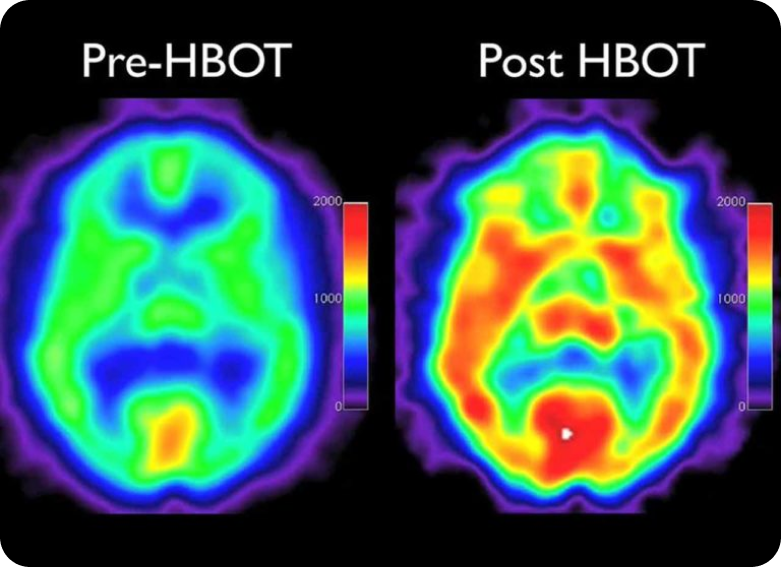What is Hyperbaric Oxygen Therapy (HBOT)?
“Hyper” means increased and “Baric”” relates to pressure. Hyperbaric Oxygen therapy (HBOT) thus refers to intermittent treatment of the entire body with 100% oxygen at greater than normal atmospheric pressures.
How Does It Work?
The earth's atmosphere normally exerts 14.7 pounds per square inch of pressure at sea level, which is equivalent to 1 atmosphere absolute. Normally we breathe approximately 20% oxygen & 80% nitrogen.
During Prana Hyperbaric Oxygen Therapy, HBOT treatment, the pressure is increased up to two times the normal and the patient breathes 100% oxygen while the entire body is totally immersed in 100% oxygen. Since the oxygen is under increased atmospheric pressure, there is increased diffusion of the oxygen into the plasma, resulting in ultimately sustained delivery of increased oxygen to the oxygen-deprived tissues. This lead to accelerated healing of various types of persistent & problematic wounds.
Benefits of Pre/Post-Operative Hyperbaric Oxygen Therapy
Reduces edema/inflammation
Enhances oxygen availability to injured tissue
Promotes fibroblast proliferation/collagen synthesis, decreasing fibrosis
Enhances antibiotic efficacy
Reduces incidence of infection due to the enhancement of leukocyte oxidative killing
Increases tensile strength of healed tissue
Increases angiogenesis
Indications
Head Injury
A head injury is any trauma or damage to the scalp, skull, or brain. It can range from mild, such as a bump or bruise, to severe, such as a concussion or skull fracture. Symptoms may include headaches, dizzines...
Testimonials
No testimonials added
Medical Gallery
Look Into Our Special Treatment
Get In Touch!
Contact us for quote, help to join the team
Contact Form
FAQ'S
A. Hyperoxygenation: HBOT physically dissolves extra oxygen into the blood plasma, which is then delivered to the tissues. Breathing pure oxygen at two to three times normal pressure delivers 10-15 times as much physically dissolved oxygen to tissues. This can increase the tissue oxygen in compromised tissues to greater-than-normal values. Hyperoxygenation has been demonstrated to induce the formation of new capillaries in ischemic or poorly perfused wounds. Therefore, it is useful in the treatment of ischemic-based compromised wounds, flaps, and grafts. It is also helpful in some infections by allowing white cell (leukocytic) activity to resume function.
Mechanical Effect of Increased Pressure: Any gas in the body will decrease in volume as the pressure on it increases. With a threefold increase in pressure, a bubble trapped in the body is reduced by two-thirds. Thus, reduction in gas volume resolves air embolism and decompression illness when the diagnosis to treatment is done in a timely manner.
Vasoconstriction: High-pressure oxygen causes constriction of the blood vessels in normal tissues without creating hypoxia. It does not cause constriction in previously oxygen-deprived tissues. The vasoconstriction decreases edema which is helpful in the treatment of burns, crush injuries, compartment syndromes, and other acute traumatic ischemias. Even though the blood flow that contributes to edema is reduced, oxygen delivery to the tissues is maintained through the hyperoxygenation effect.
Antimicrobial Activity: HBOT inhibits alpha toxin production as seen in anaerobic infections such as clostridium perfringens (gas gangrene). The most common cause of gas gangrene is clostridium perfringens; however, there are several gas-producing organisms (aerobic and anaerobic) that require surgical debridement initially. It also enhances the white cell killing activity which provides an excellent adjuvant to I.V. antibiotics and local wound care.
Mass Action of Gases: The flooding of the body with any one gas tends to “wash out” others. This action occurs more rapidly under pressure than under ordinary conditions and makes HBOT an indicated treatment for decompression sickness.
Reduction of Reperfusion Injury: Following an ischemic interval, indirect injury occurs, which is mediated by the inappropriate activation of leukocytes. HBOT prevents such activation. Adherence of white blood cells to capillary walls is markedly reduced, thus mitigating the “no-reflow” phenomenon. This is why HBOT therapy is indicated in carbon monoxide poisoning and is considered the treatment of choice.
A. HBOT has been proven effective for many medical conditions, and as a result the Undersea and Hyperbaric Medicine Society, one of the premier research institutes, has approved the following indications:
1. Air or Gas Embolism
2. Carbon Monoxide Poisoning Complicated by Cyanide Poisoning
3. Clostridal Myositis and Myonecrosis (Gas Gangrene)
4. Crush Injury, Compartment Syndrome, and other Acute Traumatic Ischemias
5. Decompression Sickness
6. Enhancement of Healing in Selected Problem Wounds; Arterial Insufficiencies; Central Retinal Artery Occlusion
6. Severe Anemia
7. Intracranial Abscess
8. Necrotizing Soft Tissue Infections
9. Refractory Osteomyelitis
10. Delayed Radiation Injury (Soft Tissue and Bony Necrosis)
11. Compromised Skin Grafts & Flaps
12. Acute Thermal Burn Injury
In addition, Medicare coverage determinations will reimburse in the U.S. for the following conditions:
1 Diabetic wounds of the lower extremities in patients who meet the following three criteria:
2. Patient has type I or type II diabetes and has a lower extremity wound that is due to diabetes;
3. Patient has a wound classified as Wagner grade III or higher; and
4. Patient has failed an adequate course of standard wound therapy.
A. Monoplace Chambers: A monoplane chamber is a system that accommodates one patient at a time. The patient lies down on a stretcher which slides into the chamber. Typically the chamber is pressurized with 100% oxygen. The patient receives 100% oxygen by breathing the oxygen inside the chamber. A mask or a hood is not needed. Monoplace chambers have the capability to be pressurized to 3 ATA. Other than decompression sickness and gas embolism, the UHMS protocols for hyperbaric therapy do not require greater than 3 ATA of pressure for treatment. Critically ill patients requiring extensive life support equipment can be treated in the Prana monoplane. (Other monoplane manufacturers do not offer all the life support capabilities). The vast majority of hyperbaric patients are treated in a monoplane chamber.
Multiplace Chambers: : A monoplane chamber is a system that accommodates one patient at a time. The patient lies down on a stretcher which slides into the chamber. Typically, the chamber is pressurized with 100% oxygen. The patient receives 100% oxygen by breathing the oxygen inside the chamber. A mask or a hood is not needed. Monoplace chambers have the capability to be pressurized to 3 ATA. Other than decompression sickness and gas embolism, the UHMS protocols for hyperbaric therapy do not require greater than 3 ATA of pressure for treatment. Critically ill patients requiring extensive life support equipment can be treated in the Prana monoplane. (Other monoplane manufacturers do not offer all the life support capabilities). The vast majority of hyperbaric patients are treated in a monoplane chamber.
A. Except for decompression sickness and arterial gas embolism, the typical treatments are approximately two hours long. Treatments are administered on an in-patient or out-patient basis. In some acute cases, treatments may be administered every eight to twelve hours.
A. Treatment protocols are established by the attending physician. Safe treatment times, dose, and pressure limits have been established for hyperbaric oxygen exposure and these limitations form the basis for all treatment protocols. While receiving therapy, the critically ill patient may be provided with mechanical ventilation, IV therapy and invasive and noninvasive physiological monitoring.
PROWELL HBOT PVT LTD
“Hyper” means increased and “Baric” relates to pressure. Hyperbaric Oxygen therapy (HBOT) thus refers to intermittent treatment of the entire body with 100% oxygen at greater then normal atmospheric pressures.
Social
Feedback Form


